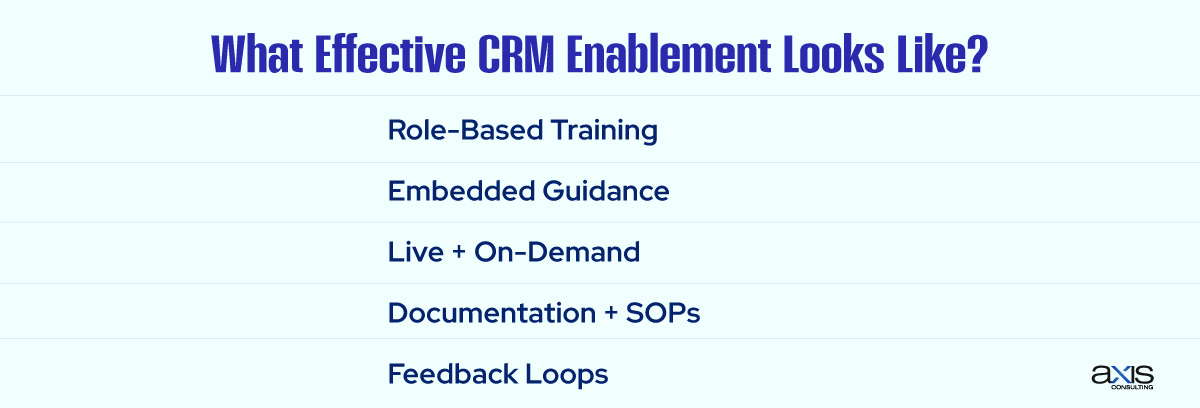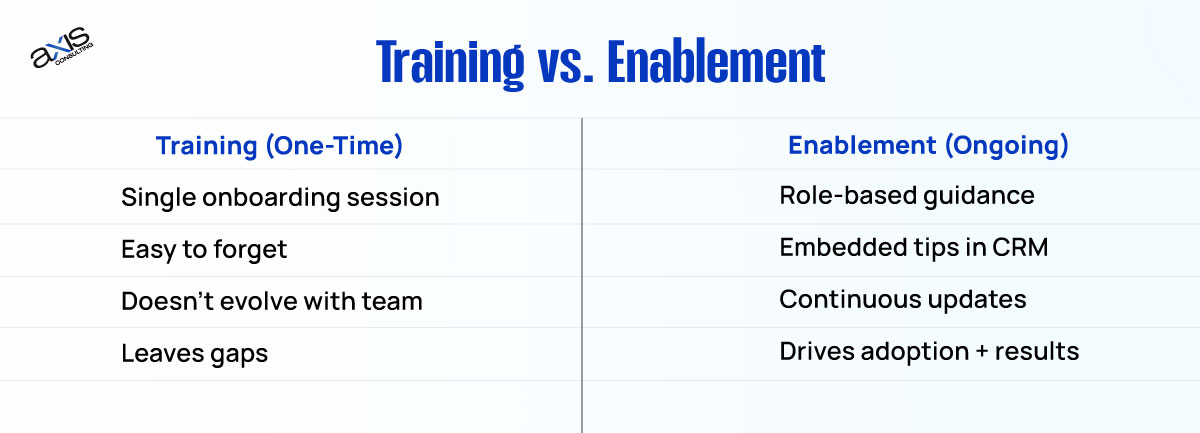Your CRM is powerful. It tracks leads, automates follow-ups, forecasts revenue, and integrates with everything. So, why is no one using it correctly? Why do deals go unlogged, fields stay blank, and reports look like guesswork?
The problem is not the tool. It is the people using it. Or more accurately, people who were never properly trained to use it. A CRM without enablement is like giving someone a plane and expecting them to fly it without lessons. This is not a tech issue. It is a training one.
Table of Contents
ToggleThe Real Reason CRM Projects Fail
Most companies blame the CRM when adoption lags. But here is the truth. Most CRM implementations fail not because of the platform, but because users are unprepared, confused, or overwhelmed.
Reps resist tools they do not understand. Managers ignore dashboards they do not trust. Leaders lose faith in data that no one owns. Without enablement, your CRM becomes just another system people avoid.
What Enablement Really Means in a CRM Context?
CRM enablement is not just a one-time onboarding session or a help center link. It is a long-term strategy that teaches your team:
- What the CRM does
- Why it matters to their role
- How to use it effectively
- When to use it in the flow of work
- How it connects to goals and compensation
Enablement ensures that your CRM is not only installed but also fully functional. It is understood, adopted, and used to drive results.
Why One-Time Training isn’t Enough?
Most rollouts include a single training session. Everyone nods along, maybe takes notes. Two days later, they are back to spreadsheets and sticky notes. One-and-done training does not work because:
- People forget
- Real questions come up later
- The system evolves
- Teams change
- Workflows grow more complex
Enablement is not a box to check. It is a habit that needs to be baked into your CRM lifecycle.
The Hidden Cost of an Untrained CRM Team

If your team is not trained, your CRM becomes a black hole. Data is inconsistent. Pipelines are inaccurate. Reports mislead. And automation fails to trigger correctly. Here is what that looks like:
- Reps skip deal stage updates
- Contact roles are left blank
- Activity notes are vague or missing
- Fields are misused or misunderstood
- Automation does not fire due to broken logic
This erodes trust. Leadership makes decisions on insufficient data. Teams stop using the system. The CRM becomes shelfware.
Enablement Turns a CRM Into a Growth Engine
When your team is trained and re-trained, the CRM becomes a high-leverage asset. Salespeople know what to log and why. Marketers get clean data. Managers coach from actual insights.
Enablement closes the gap between software features and business impact. It builds confidence, consistency, and accountability. Most importantly, it helps your CRM support your strategy, rather than slowing it down.
What Effective CRM Enablement Looks Like?

Effective enablement is part of daily operations, not a side project. Here is what it includes:
Role-Based Training
Different roles use the CRM differently. Reps, managers, marketers, and admins need training that matches their workflows.
Embedded Guidance
Tips, playbooks, and help links should be stored within the CRM when a user moves a deal or logs an activity, and surface relevant guidance.
Live and On-Demand Options
Host live trainings every quarter, and also provide users with access to short videos and tutorials for quick answers.
Documentation and SOPs
Internal guides that explain fields, stages, and workflows in plain language should be accessible directly from the CRM.
Feedback Loops
Users should be able to ask questions and suggest changes. Enablement is not just about teaching. It is about listening too.
Why Enablement Improves CRM Adoption and Data Quality?
When people understand the CRM, they use it. When they use it, the data gets better. As the data improves, so do the results, from lead routing to revenue forecasting.
Enablement drives:
- Higher rep confidence
- Faster new hire onboarding
- Cleaner records
- More accurate pipeline reviews
- Stronger automation performance
It also shapes culture. Your team stops seeing the CRM as a burden and starts seeing it as a tool that helps them win.
Enablement Should Start Before Rollout
One of the biggest mistakes companies make is launching the CRM and promising to train people later. By that time, bad habits have already formed.
Enablement should begin during planning. Involve users early. Map their workflows. Show them how the CRM will make things easier. That way, the system launches with adoption already in motion.
Who Owns CRM Enablement?
Enablement is a team effort, but it needs a clear owner. Often, that is a RevOps, a sales enablement leader, or a CRM administrator who understands business workflows.
The owner should:
- Deliver training
- Create and update documentation
- Track CRM usage
- Collect team feedback
- Continuously improve processes
If no one owns enablement, adoption becomes optional and inconsistent.
Training isn’t Optional. It’s Revenue Protection

Your CRM is not failing. Your team was never correctly shown how to use it. That can be fixed. Enablement is the bridge between software investment and business results. When it is part of your rollout, updates, and culture, the CRM starts driving revenue instead of draining it. Train early. Train often. Make your CRM helpful, not harmful, because tools do not create results; people do.
FAQs
What’s the difference between CRM training and CRM enablement?
Training is a one-time event. Enablement is ongoing, role-based, and built into workflows.
Who should be responsible for CRM enablement within a company?
A RevOps professional, sales enablement specialist, or a CRM owner with both technical and business expertise should take ownership.
How often should CRM training be updated?
Review and update quarterly, particularly after any changes to central systems or processes.
What improves CRM adoption the fastest?
Demonstrate to reps how CRM usage directly ties to faster closes, more effortless follow-ups, and improved pipeline visibility.
Is enablement worth the cost and effort?
Yes. It improves data quality, performance, and CRM ROI. Without enablement, CRM success is left to chance.